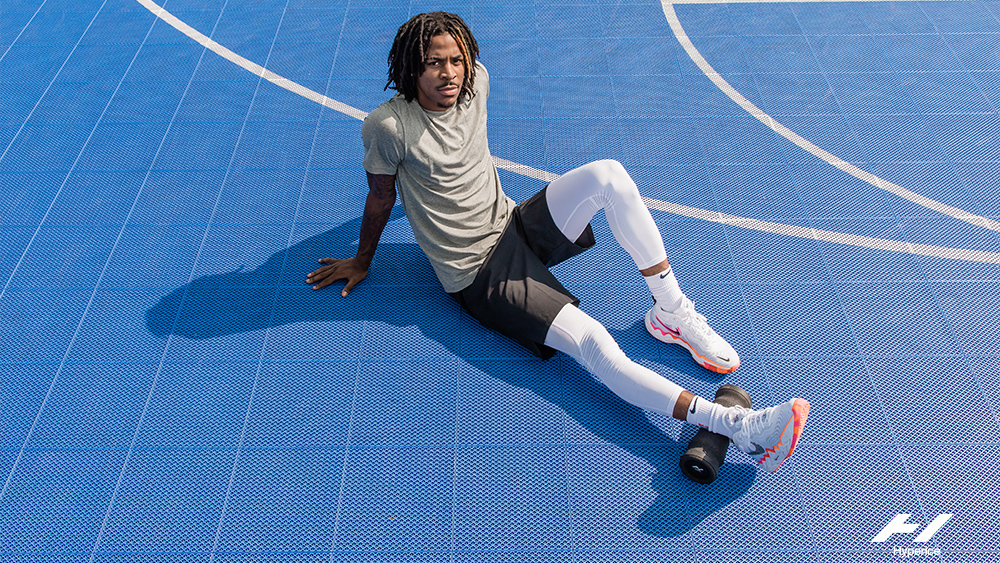Foam roller vs massage gun: Which is best to rid soreness and aid muscle recovery?
Breaking down the pros and cons of massage guns and foam rollers


The battle between foam rollers vs massage guns is fiercer than ever. There’s an increasing range of groundbreaking tech promising to help muscles recover and promote blood flow. Which is best to alleviate soreness and aid recovery?
The best foam rollers have come a long way since the first models arrived as basic, smooth tubes on which you rolled your leg and back muscles. They now come with different sized and shaped knobbles, vary in thickness and firmness, and there are even vibrating models available.
On the other hand, the best massage guns have recently arrived on the sports-massage scene to further muddy the recovery waters. Led by the market-leading Theragun, these technical percussion instruments have been embraced by physiotherapists and athletes alike due to the fact they can target specific muscles and areas of pain and, due to their design, provide more in-depth, targeted control than foam rollers.
If you’re in the market for something that will release muscle tension, not only do we break down the differences between foam rollers and massage guns below, but you should also have a read of our best massage tools guide to help you make sense of what’s out there on the market.
So when it comes to foam rollers vs massage guns, which is better? Alex Parren, personal trainer and running coach for Sundried, helps dig down into the advantages and disadvantages of both foam rollers and massage guns
Foam rollers vs massage guns: price
If you’re on a tight budget, foam rollers are your go-to option. The most basic models start as low as £5. For that price, you’ll get a small, smooth roller. As the price goes up, you’ll get added features and more protrusions. Top-end foam rollers are priced at more than £100 – see Hyperice's Vyper 3, Therabody’s Wave Roller and the Power Plate Roller – and feature tech such as different speeds of vibration, rechargeable batteries and remote controls.
Massage guns start at around £60. These usually come with interchangeable heads, and operate at speeds of up to around 3,000r/min. The tech advances quickly the more you spend, moving up to the top-of-the-range Theraguns with their distinctive triangle-shaped handles for different grips – the Theragun Pro retails for £549, and for that, the makers claim it goes 60% deeper into the muscle than the average massage gun, as well as leaving the skin 40 times a second.
Get all the latest news, reviews, deals and buying guides on gorgeous tech, home and active products from the T3 experts

Foam rollers vs massage guns: How do they work?
At the most basic level, foam rolling is the process of rolling your muscles across a tube-shaped roller. The equipment usually features raised knobs or trigger points to target muscles and help loosen muscle knots and tension. For those of you who’ve tried foam rolling, it can be a little uncomfortable at first as your tired, tense muscles begin to unwind – the process has even been known to reduce grown adults to tears.
This is because the rollers are designed to aid self-myofascial release (SMR). “Fascia is the thin tissue that surrounds muscles, joints and even internal organs,” says Parren. “Fascia is layered, and if it becomes ‘tangled’ by binding together, which can be caused by a number of reasons, you lose your flexibility, range of motion and can become prone to injury. A great way to offset this is by using SMR to unbind the fascia and, in turn, relax your muscles.”

Massage guns, meanwhile, are another example of SMR, albeit more advanced. If you’ve used one or had a physio or sports massage with one, you’ll have felt like you’ve been caught in a hailstorm with no umbrella. The massage gun works by repeatedly percussing muscle thousands of times a minute.
“The rapidly repeated vibration of the muscle stimulates blood flow and helps it to relax, leading to a better workout and faster recovery,” Parren adds.
This rapid ‘percussion’ also warms the muscles, which improves flexibility and means you’re less prone to injury.
Foam rollers vs massage guns: The benefits
There have been several scientific studies, such as this 2019 study by Frontiers in Physiology, that found that foam rolling pre-workout can improve range of motion in joints (increasing flexibility and aiding running form), and can boost the recovery process after exercise and reduce the effects of delayed onset muscle soreness (DOMS). Foam rolling is also proven to improve blood flow, which can lead to an improvement in exercise performance.
In terms of pain levels, “Foam rolling can be painful for different reasons, but the goal is not for it to hurt at all,” says Parren. “One thing to note is that some people foam roll in the wrong places, and this could be one reason you’re finding it painful. For example, one place many people incorrectly foam roll is the outside of the thigh. This area can be painful as it’s where your IT band runs down your leg, so try to avoid foam rolling in this area as you can cause inflammation and irritation.”
Parren says that massage guns and foam rollers both have very similar benefits, however, the automatic response of a massage gun could be seen as advantageous by some people.
“The movement is far more rapid than anything you would achieve using a foam roller, and it could be argued that they provide more targeted relief. However, apart from the way they are used physically, they do not provide any extra benefits when compared to foam rolling.”

Foam rollers vs massage guns: When is best to use them?
The ideal time to foam roll is post-workout. “It reduces the effects of post-exercise muscle soreness meaning you can recover more quickly and be ready for your next workout sooner,” says Parren. “It can also prevent your fascia from binding together and causing adhesions after a tough workout.”
That said, as mentioned above, foam rolling does additionally have pre-workout benefits such as improving blood flow which can help performance in your upcoming workout. You don’t need to foam roll for long – around 10 minutes daily should result in noticeable benefits.
As with foam rolling, using a massage gun both before and after a workout provides its own benefits. Promoting blood flow, improving recovery time and warming up muscles are all fantastic benefits that people should be capitalising on to improve their workouts and reduce their risk of injury.
Foam rollers vs massage guns: Verdict
Both foam rollers and massage guns have been shown to improve flexibility pre-workout and boost recovery post-workout, as well as reduce the likelihood of injury.
Foam rollers provide a more general massaging experience and are perfect if you're on a budget. They are pretty bulky to carry around, though, and it might take a while to roll all your pain away using smaller rollers. However, stopping at home shouldn't be an issue, and most gyms have at least a few lying around, so there is no need to carry it with you there.
Massage guns give more targeted percussion, so you can work specific areas deeply and smooth out knots or massage trigger points. They are a particularly good solution if you're rehabbing following injury or perform multiple hard workouts a week and don't often go for a sports massage.
It's worth noting that larger massage guns can be forceful on higher settings, so you should be extra careful using them after a strenuous workout session. Battering already sore muscles with a forceful percussive massager could cause more harm than good. We would recommend following expert advice; most big-name brands have apps that can guide massage guns via Bluetooth.
Vibrating rollers combine the best of both worlds but are equally as pricey as massage guns. Another downside is that it's harder to target sore areas on the upper body with vibrating rollers, just like with foam rollers. For runners and cyclists, it's still worth considering.

When not seeking out new running and cycling trails, Howard writes about all things health and fitness. As well as T3, he's written for a plethora of websites, newspapers and magazines including Runner’s World, Cycling Weekly, Trail Running, Women’s Running, ShortList, Fit&Well, Red Bulletin and Wareable. When not running ultramarathons he's taking on MTB singletrack trails and hiking all around the world. As a side hustle, Howard is also on an ongoing quest to find the country’s best cinnamon bun.